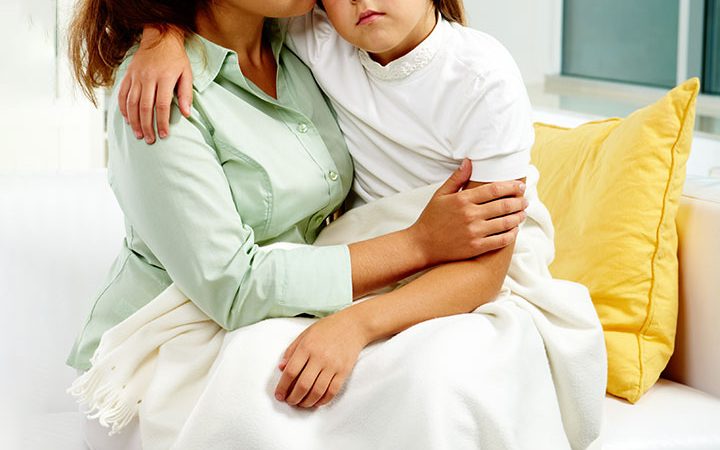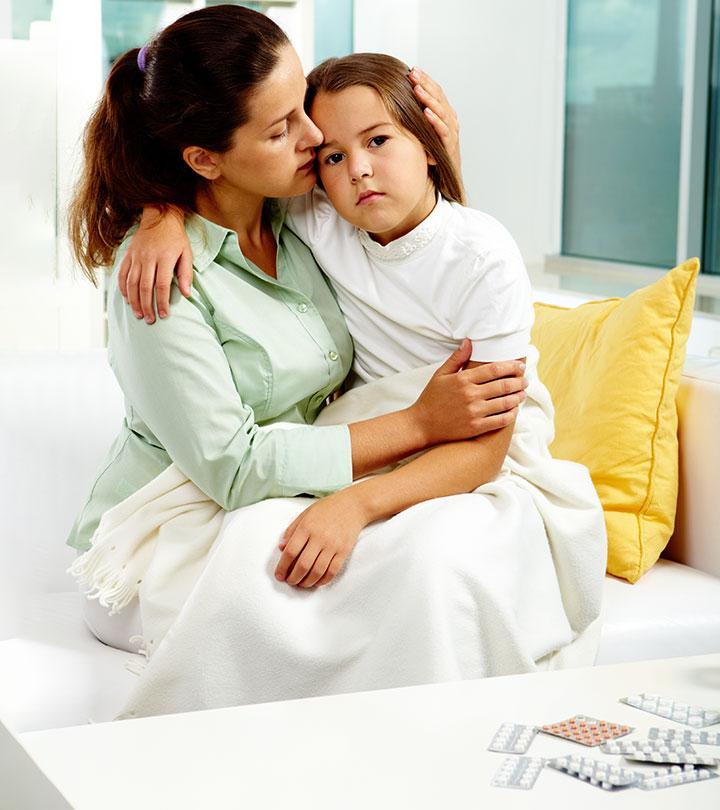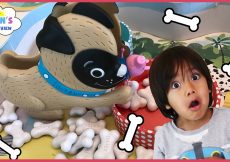Anxiety is a normal defensive mechanism of the human body to protect us from dangers. Anxiety disorders occur due to an altered perception of and response to fear and stress. This instills the urge to escape and avoid such situations to the extent that it impairs day-to-day functioning (1).
Anxiety is a common psychological disorder in children but, if left untreated, may persist to adulthood. This post talks about anxiety medication for children, their safe use, and side effects.
Anxiety In Children
Some fears and worries, such as thoughts of being separated from their parents, are typical in young children. They usually outgrow these fears as they grow older. If they persist and start interfering with their daily activities at home or school, it is a concern and requires medical attention. The types of anxiety disorders include (2):
- Separation anxiety: Fear of being separated from parents
- Phobias: Fear of a thing or situation (dogs, cats, closed spaces)
- Social anxiety: Fear of facing many people at a time in school or gatherings
- General anxiety: Worrying about bad things that may happen
Symptoms of anxiety disorder may include sudden sweating, heart pounding, shortness of breath, shaking, feeling dizzy, fatigue, stomach ache, or headache.
Age At Which Children May Take Anxiety Medications
Research shows that anti-anxiety medications work better in children aged seven years or older when used with psychotherapy (3). Anti-anxiety medication should only be given when prescribed by a doctor. The American Academy of Child and Adolescent Psychiatry (AACAP) recommends behavioral therapy as the first-line treatment for childhood anxiety with mild symptoms. Moderate to severe intensity anxiety disorder may need medications (4).
Anxiety Medications For Children
Medications that benefit anxiety were initially used to treat depressive disorders and were classified under antidepressants. All medications used for anxiety are not approved by the US Food and Drug Administration (FDA) but are prescribed “off-label” by many practitioners and are considered safe and effective.
Drugs of the class selective serotonin reuptake inhibitor (SSRI) and serotonin-norepinephrine reuptake inhibitors (SNRI) are preferably used to treat general anxiety disorder in children. Duloxetine (an SNRI) is the only FDA-approved medication for childhood anxiety disorders (5). Other drugs, such as tricyclic antidepressants (TCAs) and benzodiazepines, are less common choices for children (6).
The table below elaborates the various drugs used to treat childhood anxiety (3).
| Class | Medication with brand name | Usual dose range (mg/day) |
| SSRI | Citalopram/Escitalopram (Celexa/ Lexapro) | Starting with 10/5 up to 40/20 |
| Fluvoxamine (Luvox) | 100-300 | |
| Sertraline (Zoloft) | 25-200 | |
| Fluoxetine (Prozac, Sarafem) | 10-60 | |
| Paroxetine (Paxil, Pexeva) | 10-50 | |
| SNRI Noradrenergic agent |
Venlafaxine ER (Effexor) | 37.5-225 |
| Duloxetine (Cymbalta) | 30-120 | |
| Atomoxetine (Strattera) | 10-100 | |
| Tricyclic antidepressants | Clomipramine (Anafranil) | 75-250 |
| Benzodiazepine | Alprazolam (Xanax) | 0.5-1.5 |
| Clonazepam (Klonopin) | 0.5-3 | |
| Lorazepam (Ativan) | 1-2 | |
| Atypical anxiolytic | Buspirone (Buspar) | 15-60 |
| Antihistamine | Diphenhydramine (Benadryl, Banophen, Diphenhist) | 12.5-50 |
| Doxylamine (Unisom, WalSom) | 12.5-50 | |
| Hydroxyzine (Atarax) | 25-50 |
Source: American Academy of Child and Adolescent Psychiatry
Usually, the medications are started at the lowest dose and gradually increased based on how the child responds to it and the side effects. The child may show improvement after two to four weeks, and the best treatment dose is often identified over 8-12 weeks.
The dosing of anti-anxiety medications in children shall be decided by the doctor depending on age, body weight, and medications already used by the child. Some additional considerations regarding medications for anxiety include (3):
- Occasional intense episodes of anxiety: Clinicians may prescribe benzodiazepines (lorazepam, clonazepam) for a short duration for specific anxiety episodes such as giving a speech or performing on stage. Antihistamines (diphenhydramine and hydroxyzine) and beta-adrenergic blockers (propranolol) may also be prescribed for the said purpose.
- Occasional sleep problems: Physicians may use additional medications if the child has problems sleeping properly even after anxiety issues are resolved. Melatonin, antihistamines, sedative-antidepressants (mirtazapine), or adult insomnia medications (zolpidem, zaleplon) may be prescribed based on the physician’s discretion if behavioral approaches do not work.
Side Effects Of Anxiety Medicines For Children
Anti-anxiety medications work by modulating the effects of various neurotransmitters, such as serotonin, noradrenaline, or histamine, in the central nervous system and are not free of side effects. Some common adverse effects of these drugs include (7):
- Headache
- Sleepiness
- Insomnia
- Diarrhea
- Dry mouth
- Nausea and vomiting
- Decreased appetite
- Stomach pain
- Restlessness
- Increased heart rate
- Muscle pain
- Weight gain (more common) or loss
Serious side effects that require immediate medical attention are (3):
- Abnormal heart rhythm with TCAs, SSRIs, and antihistamines
- Seizures with antihistamines
- Withdrawal symptoms with benzodiazepines if suddenly discontinued after prolonged use.
- Rare respiratory depression is seen at very high doses of benzodiazepines
The FDA directs all manufacturers to add a boxed warning statement and extended warning statements to alert users to an increased risk of suicidality (suicidal thinking and behavior) in children and adolescents being treated with antidepressant medications (8). A rare adverse effect, serotonin syndrome (excess serotonin in the body), may be caused by SSRIs, SNRIs, or TCAs, resulting in agitated mental states with hallucinations or coma, muscle rigidity, seizures, flushing, and changes in heart rate and blood pressure (9).
Precautions While Using Anti-anxiety Medicines In Children
Below are the general precautions to be exercised while giving your child medications for anxiety.
- Make sure to inform your doctor about all other prescription drugs, OTC medications, or herbal preparations that your child is using.
- Stick to the dosage regimen and do not give a double dose for any missed dose the next day.
- Inform your healthcare provider about any side effects that your child experiences.
- Keep all types of medications out of children’s reach to avoid an accidental overdose.
According to the Centers for Disease Control and Prevention (CDC), anxiety affects about seven percent of children between the ages of three and seventeen years in the US (10). The AACAP recommends psychological therapies such as cognitive-behavioral therapy (CBT) as the first treatment approach for anxiety disorders in children. Medications should be used as a second measure or an adjunct to CBT for the maximum benefit of your child (4). Timely interventions through treatment could help avoid complications and persistence of anxiety into adulthood.
References:
MomJunction’s articles are written after analyzing the research works of expert authors and institutions. Our references consist of resources established by authorities in their respective fields. You can learn more about the authenticity of the information we present in our editorial policy.
Recommended Articles
- ADHD Medications For Children: Dosage, Side Effects, And Precautions
- What Age Should A Child Get A Phone? Uses, Benefits, And Side Effects
- Depression In Children: Types, Symptoms, Causes, Treatment, And Prevention
- Autism Spectrum Disorder In Children: Types, Causes, Treatment And Prevention
The following two tabs change content below.




































